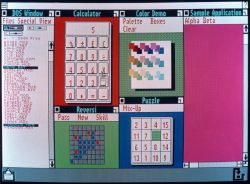(Improved) |
No edit summary |
||
| (58 intermediate revisions by 5 users not shown) | |||
| Line 1: | Line 1: | ||
{{Infobox | {{stub}} | ||
|title = | {{Infobox Buildinfo | ||
|title = Development Release #1 | |||
|image = Win1.0Beta.jpg | |image = Win1.0Beta.jpg | ||
|kernel = 1.0 | |kernel = 1.0 | ||
|arch = x86 (16-bit) | |arch = x86 (16-bit) | ||
|compiled = May 1984 | |||
}} | }} | ||
''' | '''Development Release #1''' is an early pre-release build of [[Windows 1.0]], compiled sometime in late May 1984. Only the [[wikipedia:Tandy 2000|Tandy 2000]] variant of this build is currently known to exist, however, a PC-compatible variant would've been shipped as well. | ||
== | == Overview == | ||
The | The Tandy 2000 was an Intel 80186-based computer. Since the 80186 processor was not fully compatible with the IBM PC and compatibles, this created compatibility issues dividing it from other machines of the time. The Tandy 2000 variant of this build was specifically designed for the Tandy 2000 personal computer, including the Intel 80186 processor and also the high resolution graphics (640x400 screen resolution at 16 colors) used by the machine itself. | ||
This build was launched from a file called <code>DEMO.BAT</code> and was intended to be ran from a single 5,25" floppy disk. This loaded a copy of Windows with several sample applications which could easily be loaded from there. | |||
This build uses the <code>.MOD</code> extension for applications, predating the [[wikipedia:New Executable|NE]] executable format. | |||
This | |||
== File list == | |||
<div class="toccolours mw-collapsible mw-collapsed"> | <div class="toccolours mw-collapsible mw-collapsed"> | ||
File list (as seen in the DOS Window) | |||
<div class="mw-collapsible-content"> | <div class="mw-collapsible-content"> | ||
* <code>BOXES.MOD</code>/<code>BOXES.RES</code> - Boxes application | |||
* <code>CALC.MOD</code>/<code>CALC.RES</code> - Calculator application | |||
* <code>CLIP.MOD</code>/<code>CLIP.RES</code> - Clipboard application | |||
* <code>COMMAND.COM</code> - Microsoft MS-DOS command interpreter | |||
* <code>CONFIG.BIN</code> - The system configuration file | |||
* <code>CURSOR.MOD</code> - The Cursor Routines file | |||
* <code>DEMO.BAT</code> - A batch file used to launch the Microsoft Windows demonstration | |||
* <code>DISPLAY.MOD</code> - Display driver | |||
* <code>FONT.RES</code> - Font resources | |||
* <code>GDI.MOD</code> - GDI (Graphics Device Interface) system file | |||
* <code>GDI16.MOD</code> - GDI (Graphics Device Interface) 16-bit system file | |||
* <code>GDI8.MOD</code> - GDI (Graphics Device Interface) 8-bit system file | |||
* <code>KERNEL.MOD</code> - Microsoft Windows kernel system file | |||
* <code>KEYBOARD.MOD</code> - Keyboard system file | |||
* <code>KEYNAMES.BIN</code> - Input translation table lookup file | |||
* <code>MB.EXE</code> - Module boot | |||
* <code>MOUSE.MOD</code> - Mouse driver | |||
* <code>PUZZLE.MOD</code>/<code>PUZZLE.RES</code> - Puzzle application | |||
* <code>REVERSI.MOD</code>/<code>REVERSI.RES</code> - Reversi application | |||
* <code>SAMPLE.MOD</code>/ <code>SAMPLE.RES</code> - Sample application | |||
* <code>SHELL.MOD</code>/<code>SHELL.RES</code> - "DOS Window" shell application (later became MS-DOS Executive (<code>MSDOS.EXE</code>) | |||
* <code>TEST.MOD</code> - Test executable file | |||
* <code>TIMER.MOD</code> - System timer driver | |||
* <code>WINDOWS.MOD</code>/<code>WINDOWS.RES</code> - Microsoft Windows User component | |||
</div> | </div> | ||
</div> | </div> | ||
[[Category:Windows 1.0]] | |||
Latest revision as of 19:45, 28 April 2023
| The following article is a stub. You can help BetaArchive Wiki by expanding it. |
 |
|
| Kernel version | 1.0 |
|---|---|
| CPU architecture | x86 (16-bit) |
| Compile date | May 1984 |
Development Release #1 is an early pre-release build of Windows 1.0, compiled sometime in late May 1984. Only the Tandy 2000 variant of this build is currently known to exist, however, a PC-compatible variant would've been shipped as well.
Overview
The Tandy 2000 was an Intel 80186-based computer. Since the 80186 processor was not fully compatible with the IBM PC and compatibles, this created compatibility issues dividing it from other machines of the time. The Tandy 2000 variant of this build was specifically designed for the Tandy 2000 personal computer, including the Intel 80186 processor and also the high resolution graphics (640x400 screen resolution at 16 colors) used by the machine itself.
This build was launched from a file called DEMO.BAT and was intended to be ran from a single 5,25" floppy disk. This loaded a copy of Windows with several sample applications which could easily be loaded from there.
This build uses the .MOD extension for applications, predating the NE executable format.
File list
File list (as seen in the DOS Window)
BOXES.MOD/BOXES.RES- Boxes applicationCALC.MOD/CALC.RES- Calculator applicationCLIP.MOD/CLIP.RES- Clipboard applicationCOMMAND.COM- Microsoft MS-DOS command interpreterCONFIG.BIN- The system configuration fileCURSOR.MOD- The Cursor Routines fileDEMO.BAT- A batch file used to launch the Microsoft Windows demonstrationDISPLAY.MOD- Display driverFONT.RES- Font resourcesGDI.MOD- GDI (Graphics Device Interface) system fileGDI16.MOD- GDI (Graphics Device Interface) 16-bit system fileGDI8.MOD- GDI (Graphics Device Interface) 8-bit system fileKERNEL.MOD- Microsoft Windows kernel system fileKEYBOARD.MOD- Keyboard system fileKEYNAMES.BIN- Input translation table lookup fileMB.EXE- Module bootMOUSE.MOD- Mouse driverPUZZLE.MOD/PUZZLE.RES- Puzzle applicationREVERSI.MOD/REVERSI.RES- Reversi applicationSAMPLE.MOD/SAMPLE.RES- Sample applicationSHELL.MOD/SHELL.RES- "DOS Window" shell application (later became MS-DOS Executive (MSDOS.EXE)TEST.MOD- Test executable fileTIMER.MOD- System timer driverWINDOWS.MOD/WINDOWS.RES- Microsoft Windows User component